Yellow flowering plants encompass a diverse and captivating group of botanical wonders, offering a wide array of colors, forms, and characteristics. From the radiant hues of sunflowers to the delicate blossoms of daffodils, these cheerful blooms add warmth, vibrancy, and beauty to gardens, landscapes, and natural habitats around the world.
Yellow flowering plants come in a multitude of shapes and sizes, ranging from towering sunflowers to ground-hugging buttercups. They include annuals, perennials, shrubs, trees, and even vines, each with its unique growth habits, foliage, and bloom times. Whether they bloom in spring, summer, or fall, yellow flowers offer a timeless elegance and an enduring charm that captivates gardeners and nature enthusiasts alike. In the language of flowers, yellow blooms convey messages of warmth, positivity, and the simple pleasures of life, evoking feelings of sunshine and cheerfulness wherever they bloom.
Yellow flowering plants enrich our lives with their beauty, symbolism, and ecological importance. Whether adorning gardens, landscapes, or natural habitats, these radiant blooms inspire awe and appreciation for the wonders of the natural world. With their timeless elegance and cheerful demeanor, yellow flowers continue to brighten our days and lift our spirits, reminding us to embrace life’s beauty and find joy in the simplest of pleasures.
Sunflower
Growing and caring for sunflowers, which produce bright yellow flowers, can be a rewarding experience. Sunflowers come in different sizes and colors. For yellow flowers, select varieties such as ‘Sunrich’ or ‘Sunbeam’, which are known for their vibrant yellow blooms. Sunflowers thrive in full sun, so choose a spot in your garden that receives at least 6-8 hours of direct sunlight per day. Ensure the soil is well-drained. Sunflowers typically bloom in late summer to early fall. Enjoy the beauty they bring to your garden.
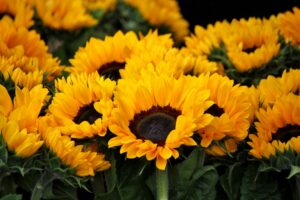
Daffodils
Daffodils, with their vibrant yellow blossoms, herald the arrival of spring with unparalleled grace and charm. These iconic flowers, scientifically known as Narcissus, captivate hearts and minds with their cheerful hues and delicate trumpet-shaped petals. Emerging from the earth as winter loosens its grip, daffodils blanket gardens, parks, and landscapes with a tapestry of golden brilliance, symbolizing renewal, hope, and the promise of new beginnings.
Rose
In a world filled with roses of every hue, the yellow flowering rose stands out as a beacon of light and optimism, reminding us to cherish the beauty that surrounds us and embrace the joy that each day brings. Whether given as a gift or enjoyed in the garden, the yellow rose serves as a timeless reminder of the enduring power of love, friendship, and the simple pleasures of life.
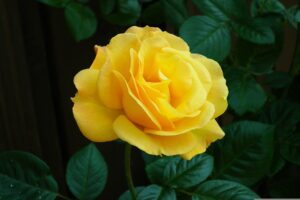
Cultivating and caring for yellow roses is a rewarding endeavor, as these resilient plants thrive in a variety of climates and conditions. With proper care, they can flourish year after year, rewarding gardeners with a profusion of dazzling blooms and lush foliage.
Marigold
Marigolds, with their cheerful golden blooms, are a beloved fixture in gardens, landscapes, and cultural traditions around the world. These vibrant flowers, scientifically known as Tagetes, captivate with their radiant color, distinctive aroma, and versatile uses.
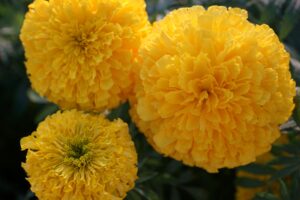
With their bright yellow petals and contrasting green foliage, marigolds bring a burst of sunshine to any setting, adding warmth and vibrancy to gardens, borders, and floral arrangements. Their compact, bushy growth habit and prolific flowering make them an ideal choice for adding color to containers, edging pathways, or filling empty spaces with bursts of vivid hues.
Tulips
Tulips, with their graceful, cup-shaped blooms and vibrant array of colors, including shades of yellow, are among the most beloved and iconic flowers in the world. Originating from Central Asia, tulips have a rich and storied history, dating back to ancient times when they were cultivated by civilizations such as the Ottomans and Persians.
Today, tulips are cultivated and cherished worldwide for their exquisite beauty and wide-ranging colors and forms. From traditional single-flowered varieties to elaborate parrot tulips with fringed petals, there is a tulip to suit every taste and style. Yellow tulips, in particular, radiate warmth and positivity, symbolizing happiness, cheerfulness, and new beginnings. Whether planted en masse in garden beds, displayed in bouquets, or used as accents in floral arrangements, their bright, sunny blooms never fail to uplift and inspire.
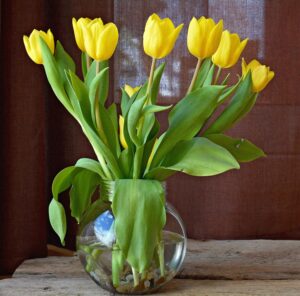
Dahlia Yellow Flowers
As they unfurl their petals and bask in the warmth of the sun, yellow dahlias remind us to embrace life’s beauty, celebrate diversity, and find joy in the simple pleasures of nature. Dahlias, with their dazzling array of colors and intricate petal formations, stand as vibrant symbols of beauty and diversity in the world of flowers. Among their many captivating hues, yellow dahlias exude warmth, joy, and optimism, captivating hearts with their sunny disposition and radiant blooms.
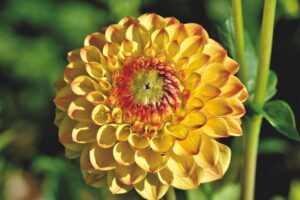
Pansy
Pansies, with their charming “faces” and a kaleidoscope of colors, including delightful shades of yellow, are beloved flowers that bring joy and cheer to gardens, containers, and landscapes. These petite yet resilient blooms, scientifically known as Viola tricolor var. hortensis, captivate hearts with their whimsical appearance and vibrant hues.
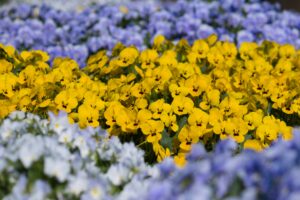
Pansies are renowned for their versatility and adaptability, thriving in both cool and moderate climates. They bloom profusely from early spring to late fall, providing continuous color and interest throughout the growing season.
Lilies
Lilies, with their graceful form and exquisite blooms, stand as majestic symbols of purity, elegance, and beauty in the world of flowers. Among the various hues they boast, yellow lilies exude warmth, radiance, and optimism, captivating hearts with their luminous presence and delicate fragrance.
Yellow lilies, in particular, captivate with their vibrant blooms and striking presence. Whether planted in gardens, displayed in bouquets, or showcased in ceremonial arrangements, their radiant petals command attention and inspire admiration.
As they unfurl their petals and reach toward the sun, yellow lilies remind us to embrace life’s beauty, celebrate diversity, and find joy in the simple pleasures of nature. With their timeless elegance and enduring charm, these magnificent flowers continue to captivate and inspire generations of gardeners, artists, and flower enthusiasts around the world.
Carnation
Carnations, with their ruffled petals and delicate fragrances, are among the most beloved and versatile flowers in the world. While traditionally associated with hues of pink, red, and white, carnations also come in stunning shades of yellow, adding a touch of warmth and vibrancy to bouquets, arrangements, and gardens.
Originating from the Mediterranean region, carnations have a rich and storied history dating back over 2,000 years. Revered by ancient civilizations such as the Greeks and Romans, these flowers were used in religious ceremonies, festivals, and celebrations, earning them the moniker “The Flowers of the Gods.”
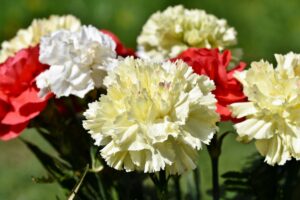
Today, carnations are cultivated and cherished worldwide for their timeless beauty and symbolic significance. With their frilly petals and sweet, spicy scent, yellow carnations exude warmth, happiness, and joy, making them popular choices for expressing affection, gratitude, and friendship.
Zinnia
As they sway in the summer breeze and bask in the warm sunlight, yellow zinnias remind us to embrace life’s simple pleasures, find beauty in every moment, and savor the vibrant colors of nature. With their timeless charm and enduring beauty, these beloved flowers continue to captivate and inspire generations of gardeners and flower lovers around the world.

Zinnias, with their vibrant colors and cheerful blooms, are quintessential symbols of summer and garden beauty. Among the multitude of hues they offer, yellow zinnias shine brightly, infusing gardens and landscapes with warmth, energy, and joy.
Cosmos
Cosmos flowers, with their delicate petals and ethereal beauty, grace gardens and landscapes with a sense of whimsy and charm. While they are commonly seen in shades of pink, white, and purple, cosmos also come in delightful hues of yellow, adding a cheerful and sunny touch to any floral display. Their bright, cheerful blooms add a burst of color to garden borders, wildflower meadows, and cottage-style landscapes, attracting bees, butterflies, and other pollinators with their nectar-rich flowers.
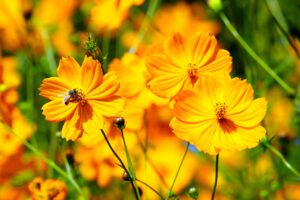
In addition to their aesthetic appeal, cosmos are valued for their versatility and ease of cultivation. They thrive in a wide range of soil types and climates, blooming profusely from early summer until the first frost. With minimal care, cosmos can self-sow and naturalize, creating a stunning display of color year after year.
Chrysanthemum
Chrysanthemums, affectionately known as “mums,” are revered for their vibrant colors, intricate petals, and rich cultural significance. Among the diverse array of hues they offer, yellow chrysanthemums stand out with their bright and cheerful blooms, symbolizing joy, friendship, and optimism.
Originating from East Asia, particularly China and Japan, chrysanthemums have a long and illustrious history dating back over 2,500 years. Revered by ancient civilizations for their medicinal properties, ornamental beauty, and symbolic significance, these resilient flowers have become cherished favorites in gardens, floral arrangements, and cultural traditions around the world.
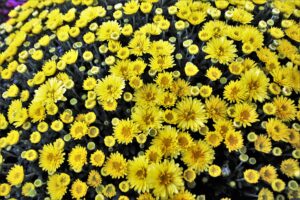
Snapdragon
Snapdragons, with their whimsical blooms and vibrant colors, add a touch of playfulness and charm to gardens, borders, and floral arrangements. While they are commonly seen in shades of pink, red, and purple, snapdragons also come in delightful hues of yellow, bringing warmth and cheer to any landscape.
Yellow snapdragons, in particular, captivate with their sunny disposition and enchanting blooms. Their vibrant spikes of tubular flowers resemble tiny dragon heads, inviting pollinators such as bees and butterflies to explore their nectar-rich blossoms.
Gladiolus
Gladiolus, with their towering spikes of vibrant blooms, are iconic symbols of strength, beauty, and resilience in the world of flowers. Among their many captivating hues, yellow gladiolus stand out with their radiant petals, evoking feelings of warmth, vitality, and joy.
Yellow gladiolus, in particular, captivate with their graceful form and luminous blooms. Their towering spikes, adorned with elegant florets, add vertical interest and drama to gardens, borders, and floral arrangements, making them popular choices for adding height and structure to landscapes.
Orchids
Orchids, with their exquisite beauty and enchanting allure, are among the most coveted and revered flowers in the world. While they are renowned for their diverse array of colors, shapes, and sizes, yellow orchids stand out with their radiant blooms, evoking feelings of warmth, elegance, and sophistication.
Yellow orchids, in particular, captivate with their delicate petals and luminous blooms. From the elegant Phalaenopsis to the exotic Oncidium, each variety of yellow orchid exudes its unique charm and personality, adding a touch of luxury and refinement to any setting.
Freesia
Freesias, with their delicate blossoms and captivating fragrances, are cherished flowers that add elegance and charm to gardens, bouquets, and floral arrangements. While they are available in a variety of colors, including white, pink, and purple, freesias also bloom in enchanting shades of yellow, infusing any setting with warmth, joy, and sophistication.
Yellow freesias, in particular, captivate with their graceful form and sweet, citrus-like fragrance. Their slender stems and clusters of trumpet-shaped blooms add a touch of romance and sophistication to gardens, borders, and floral arrangements, making them popular choices for weddings, special events, and everyday enjoyment.
Gerbera daisies
Gerbera daisies, with their large, colorful blooms and cheerful appearance, are beloved flowers that bring joy and vibrancy to gardens, bouquets, and floral arrangements. Yellow gerbera daisies, in particular, captivate with their bold, daisy-like blooms and vibrant color. Their large, showy flowers and long, sturdy stems make them ideal choices for creating eye-catching floral arrangements, whether used as focal points or as accents to other blooms.
Daisy
Daisies, with their simple yet charming appearance and bright, cheerful blooms, are beloved symbols of purity, innocence, and natural beauty in the world of flowers. Daisies belong to the Asteraceae family and are native to Europe, North America, and parts of Asia. Yellow daisies, in particular, captivate with their bright, daisy-like blooms and cheerful disposition. Their simple yet elegant flowers, consisting of a golden-yellow center surrounded by white or yellow petals, evoke feelings of warmth, happiness, and optimism.
Iris
Belonging to the Iridaceae family, irises are native to various regions around the world, including Europe, North America, and Asia. Irises, with their elegant form and exquisite blooms, are revered for their beauty, grace, and symbolism. While they are known for their mesmerizing shades of blue, purple, and white, irises also bloom in captivating shades of yellow, adding a touch of warmth and radiance to gardens, landscapes, and floral arrangements.
Buttercups
Buttercups are characterized by their bright yellow petals and glossy, cup-shaped flowers, which resemble tiny cups of butter—hence their name. Their simple yet enchanting blooms, often adorned with delicate stamens and glossy foliage, evoke feelings of warmth, happiness, and nostalgia.
Strawflowers
Strawflowers, also known as Everlasting Flowers, are captivating blooms renowned for their vibrant colors, papery petals, and long-lasting beauty. While they are available in various hues, including shades of pink, red, and orange, strawflowers also bloom in delightful shades of yellow, adding a sunny and cheerful touch to gardens, bouquets, and dried floral arrangements. These resilient and drought-tolerant plants have adapted to thrive in arid climates, making them popular choices for gardens and landscapes with sandy or well-drained soil. Strawflowers are characterized by their distinctive daisy-like blooms, which feature a central disk surrounded by rows of papery petals.
Begonia
Belonging to the Begoniaceae family, begonias are native to tropical and subtropical regions of Asia, Africa, and the Americas. Begonias, with their lush foliage and beautiful blooms, are popular and versatile plants that brighten gardens, containers, and indoor spaces around the world.
Begonias are prized for their ornamental foliage, which ranges from glossy green to variegated and textured leaves. Their flowers, which come in a variety of shapes and sizes, add an extra layer of beauty and interest to these versatile plants.
Petunia
Petunias, with their vibrant blooms and cascading habit, are popular flowering plants that add color and charm to gardens, containers, and hanging baskets. Belonging to the Solanaceae family, petunias are native to South America, particularly regions of Argentina and Brazil. These versatile and adaptable plants have become cherished favorites among gardeners and flower enthusiasts worldwide, thanks to their profuse blooming habit and ease of cultivation.
Daylilies
Daylilies, known scientifically as Hemerocallis, are beloved flowering plants cherished for their vibrant blooms, resilience, and ease of cultivation. Native to Asia, daylilies have a rich history dating back thousands of years. Yellow daylilies, in particular, captivate with their bold and radiant blooms, evoking feelings of warmth, happiness, and optimism. Their trumpet-shaped flowers, which typically last for a single day hence the name “daylilies,” are borne on tall, slender stems and open in succession throughout the blooming season, providing a continuous display of color and beauty.
Ranunculus
While ranunculus is more commonly associated with vibrant hues of pink, red, and orange, some varieties produce stunning yellow blooms. Ranunculus, also known as Persian buttercups, are prized for their delicate, layered petals and vibrant colors. The yellow varieties of ranunculus add a bright and cheerful pop of color to gardens, containers, and floral arrangements. They typically bloom in late spring to early summer, producing abundant flowers atop tall, slender stems. Their intricate, rose-like blooms create a striking focal point in the garden or as cut flowers in bouquets.
Helenium Yellow Flowering Plants
Helenium, commonly known as sneezeweed, is a genus of flowering plants in the sunflower family (Asteraceae). While the majority of helenium species produce blooms in shades of orange, red, and bronze, some varieties boast stunning yellow flowers, adding a bright and cheerful presence to gardens and landscapes. Yellow flowering heleniums typically produce daisy-like blooms with prominent, golden-yellow petals surrounding a central disk. These flowers often bloom in late summer to early fall, providing a burst of color when many other plants are winding down for the season. The vibrant blooms of yellow helenium attract pollinators such as bees and butterflies, making them not only beautiful additions to the garden but also beneficial for local ecosystems.
Celosia
Celosia, also known as cockscomb or woolflowers, is a genus of flowering plants in the amaranth family (Amaranthaceae). Yellow flowering celosia typically features vibrant, golden-yellow flower spikes that rise above the foliage, creating a striking visual display. The flowers may have a feathery or plumed appearance, depending on the cultivar. Some popular yellow-flowering celosia varieties include ‘Flamingo Feather’ and ‘Yellow Toreador.’
Rudbeckia (Black-eyed Susan)
Rudbeckia, commonly known as Black-eyed Susan, is a vibrant and popular perennial plant celebrated for its bright and cheerful blooms. This North American native wildflower is a staple in gardens and landscapes, providing a burst of color and attracting pollinators like bees and butterflies.
Black-eyed Susan yellow flowering plants typically produce large, daisy-like flowers with golden-yellow petals surrounding a dark brown or black center, resembling a “black eye.” These striking blooms are borne on sturdy stems, adding vertical interest to garden borders and wildflower meadows.
Coreopsis Yellow Flowering Plants
Yellow flowering Coreopsis, commonly known as Tickseed, is a delightful and versatile perennial plant prized for its profusion of bright, daisy-like blooms and airy foliage. Coreopsis plants typically produce masses of yellow, sun-like flowers with prominent central disks, reminiscent of cheerful daisies. The blooms rise above the foliage on wiry stems, creating a stunning display of color from early summer through fall.
One of the most popular species is Coreopsis verticillata, known for its finely textured foliage and abundance of yellow flowers. Another common variety is Coreopsis grandiflora, which features larger blooms and a more compact growth habit.
Golden Columbine (Aquilegia chrysantha)
Step into the enchanting world of your garden with the captivating beauty of the Golden Columbine (Aquilegia chrysantha). With its delicate, lantern-like yellow flowers gracefully dangling from slender stems, this exquisite perennial is a true gem in any landscape. The Golden Columbine’s intricate blooms, adorned with long, elegant spurs, dance in the breeze, attracting pollinators like hummingbirds and butterflies to your outdoor sanctuary.
As sunlight filters through the dappled foliage, casting a golden glow upon the garden, the Golden Columbine adds a touch of whimsy charm to your outdoor oasis. Whether nestled among rock gardens, lining pathways, or tucked into shady corners, this resilient and graceful plant is sure to delight gardeners and nature lovers alike, inviting you to savor the magic of nature’s finest creations right in your backyard.


